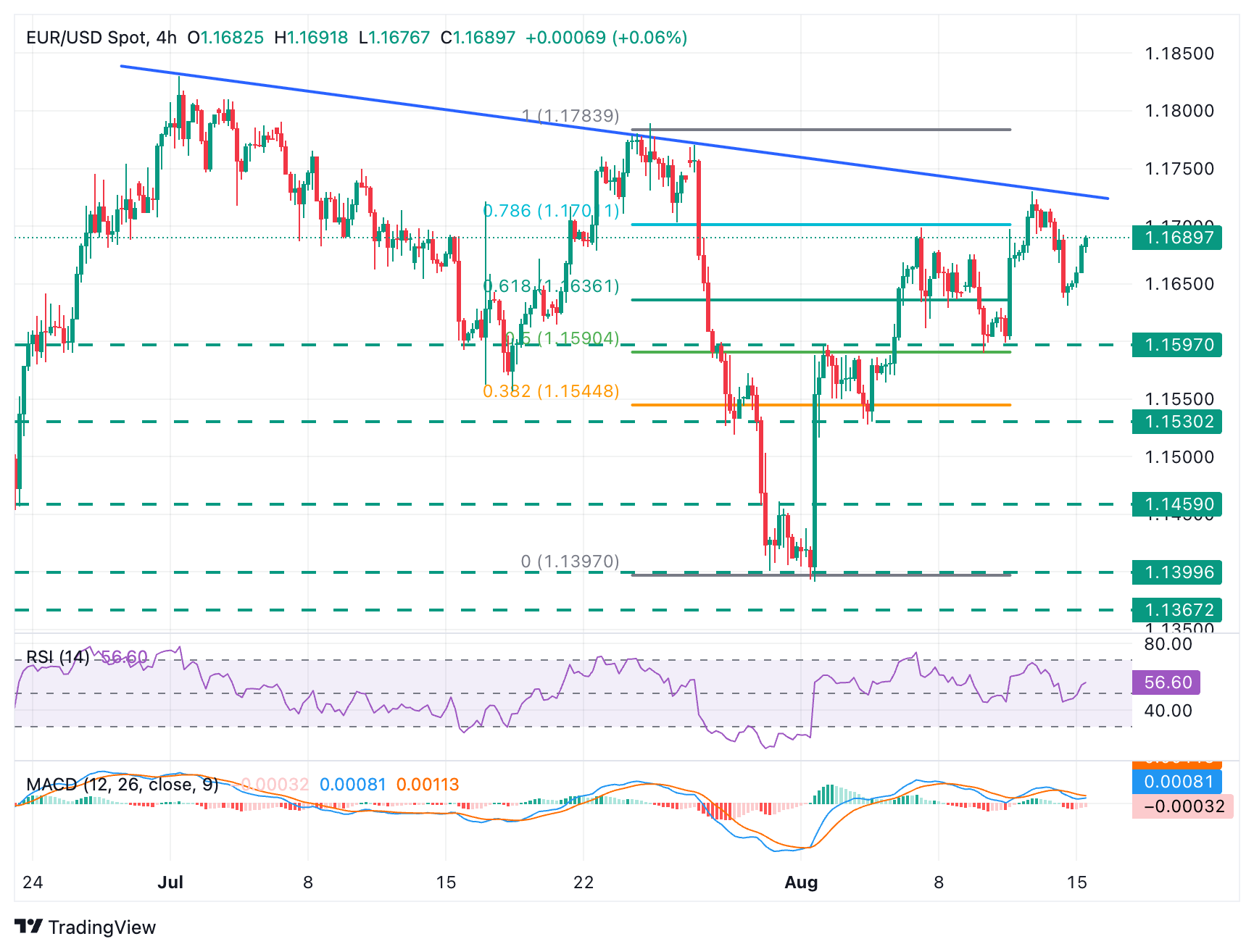EUR/USD Bounces Up With Ukraine's Summit, U.S. Retail Sales On Tap

Image Source: Pixabay
The EUR/USD nudges up on Friday following a nearly 0.5% reversal on Thursday, but it is still below 1.1700 at the early European trading session and well below weekly highs at 1.1730. The common currency is drawing support from a moderate US Dollar pullback amid moderate optimism about the outcome of Ukraine's summit, and with one eye on the US Retail sales report.
On Thursday, US data showed that wholesale prices increased at the fastest pace in the last three years in July, adding to evidence of the impact of trade tariffs and posing a challenge to the Federal Reserve (Fed), which will have to fine-tune its monetary policy in a context of slow growth and high inflation. Fed Chairman Jerome Powell will speak at the Jackson Hole Symposium next week and might give further guidance about the bank's monetary policy plans.
In Europe, the second estimate of the Q2 Eurozone Gross Domestic Product GDP confirmed that the economy grew by a meager 0.1% in the quarter and 1.4% year-on-year, down from 0.6% and 1.5% in the previous quarter. Beyond that, a sharper-than-expected decline in Industrial Production added to evidence of the soft momentum of the region's economy and increased negative pressure on the Euro (EUR).
In the US calendar on Friday, July's Retail Sales will be watched with interest to assess the impact of the tariff turmoil on consumer spending. The main focus, however, is likely to be on the meeting between the US President, Donald Trump, and the Russian leader, Vladimir Putin, to negotiate the end of the conflict in Ukraine. There is little chance of a breakthrough, but any progress towards the end of the hostilities will be welcomed by the market and provide additional support to the Euro.
Daily digest market movers: Dollar upside attempts remain limited
- The strong US PPI figures cooled hopes of a large Fed cut in September, but the market is still pricing a 25 basis point rate cut. This is keeping investors' appetite for risk alive and acting as a headwind for any US Dollar recovery.
- On Thursday, data from the Department of Labor showed that producer prices surged by 0.9% in July, and by 3.3% in the previous 12 months, beating expectations of a 0.2% monthly and a 2.5% yearly reading. Likewise, the core PPI accelerated to a 0.9% monthly and 3.7% yearly pace, well beyond the 0.2% and 2.9% readings forecasted by market analysts.
- The data release crushed hopes of a 50 basis points cut in September, but chances of a quarter-point rate cut are priced above 90%, according to figures by the CME Group's FedWatch Tool. This is keeping the US Dollar near recent lows.
- US Initial Jobless Claims declined by 3,000, to 224,000, against expectations of an increase to 228,000. These figures eased concerns about the deterioration of the labour market, at least for now, and helped to tone down the drama of July's Producer Prices.
- At 12:30 GMT, US Retail Sales are expected to show that consumption remains resilient with a 0.5% growth in July, following a 0.6% rise in June. Excluding automobiles, sales of all other products are expected to have increased by 0.3% after a 0.5% increment in the previous month.
- Eurozone figures released on Thursday showed that employment increased by 0.1% in Q2, down from the 0.2% growth seen in the first quarter. Year on year, net employment rose 0.7%, at the same pace as in the previous quarter, against expectations of a moderate slowdown to 0.6%.
- Eurozone Industrial production, on the other hand, deteriorated beyond expectations with a 1.3% contraction in June, exceeding the market expectations of a 1% decline, following a 1.1% increase in May. Year-on-year, Industrial Production fell 0.2% after a 3.1% growth in May. The market consensus anticipated a 1.7% increase.
Technical Analysis: EUR/USD remains capped below trendline resistance at 1.1730
(Click on image to enlarge)

The EUR/USD's immediate bias remains positive, but bulls have lost steam after being rejected at the descending trendline from July 1 highs, now at 1.1730. The 4-hour Relative Strength Index (RSI) is wavering around the 50 line, and shows a bearish divergence that should act as a warning for bulls.
The pair found support on Thursday at 1.1635 and is trading higher at the time of writing, but the failure to break the mentioned trendline might give fresh hopes for sellers. First support is seen at 1.1590, which broadly aligns with the August 11 low and August 4 high, ahead of the August 5 low at around 1.1530 and the July 31 high at 1.1460.
To the upside, the trendline at 1.1735 poses a serious challenge for Euro bulls as it capped the pair several times in July and also on August 13. A confirmation above that level would signal the end of the correction from early July highs and shift the focus towards the July 24 highs at 1.1789 and the July 1 highs at 1.1830.
More By This Author:
Japanese Yen Rises On Strong GDP As USD Recovery Momentum Fades
Silver Price Forecast: Silver Slips As US Dollar Firms On Strong PPI Data
Gold Retreats As U.S. Dollar Rebounds On Stronger-than-expected PPI, Steady Jobless Claims



